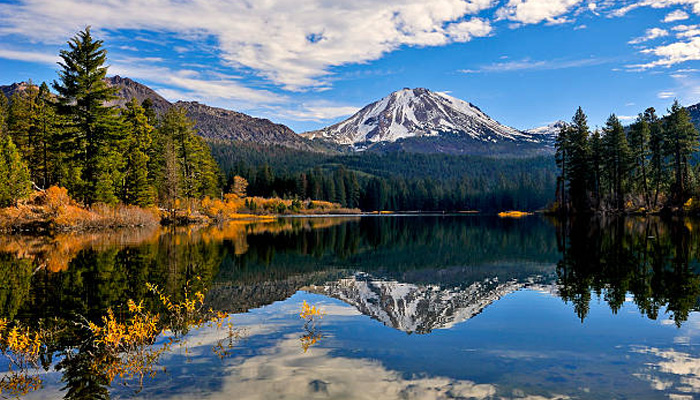When most people think of U.S. national parks, names like Yellowstone, Yosemite, and Grand Canyon immediately come to mind. But beyond these famous icons lies a treasure trove of lesser-known parks that offer stunning landscapes, abundant wildlife, and peaceful escapes from the crowds. If you’re looking for a unique adventure without fighting hordes of tourists, these underrated national parks are calling your name. From hidden canyons to serene lakes and secret waterfalls, there’s a whole world of natural beauty waiting to be explored.
1. Lassen Volcanic National Park, California

Tucked away in Northern California, Lassen Volcanic National Park is a geothermal wonderland that few have experienced. Steam vents, bubbling mud pots, and boiling springs dot the landscape, making it feel like another planet. Unlike the busy trails of more famous parks, Lassen offers serene hikes like the Bumpass Hell Trail, which takes you past fumaroles and hot springs. For families, there are easy loops that let children safely explore geothermal features while learning about volcanic activity. If you love solitude and a touch of adventure, Lassen is a hidden gem worth visiting, especially in summer when wildflowers bloom around the park’s volcanic peaks.
2. Congaree National Park, South Carolina
For a different kind of natural spectacle, Congaree National Park offers one of the tallest deciduous forests in the United States. Boardwalks and hiking trails wind through giant hardwoods and cypress trees, creating a cathedral-like atmosphere. Canoeing or kayaking along Cedar Creek gives you an intimate view of wildlife, including deer, otters, and a variety of birds. Its quiet, swampy environment makes Congaree a hidden gem for those seeking a peaceful connection with nature. Birdwatchers and photographers often find Congaree especially rewarding, capturing moments that are impossible to see in more crowded parks.
3. Great Basin National Park, Nevada

Nevada might be known for bright lights and desert landscapes, but Great Basin National Park is a serene high-altitude escape. Home to ancient bristlecone pines, the oldest living trees on Earth, this park combines alpine peaks, caves, and star-studded night skies. The Lehman Caves are a must-see, with intricate limestone formations that feel like a secret underground world. Hike to Wheeler Peak for panoramic views, and stay after dark for some of the best stargazing in the country. Great Basin’s remote location also means you’ll likely share the trails with few people, allowing for a peaceful and immersive nature experience.
4. Isle Royale National Park, Michigan

Located in Lake Superior, Isle Royale is accessible only by boat or seaplane, which helps preserve its remote and tranquil environment. Moose and wolves roam freely, offering wildlife encounters that feel truly off the beaten path. Kayaking, hiking, and camping on the island are immersive experiences, allowing visitors to disconnect from modern life and reconnect with the raw beauty of nature. Its isolation makes it a dream destination for adventurous travelers who crave solitude and wildlife viewing. For those willing to make the journey, Isle Royale offers a sense of adventure akin to exploring an untouched wilderness.
5. North Cascades National Park, Washington
Sometimes called the “American Alps,” North Cascades National Park is a haven for hikers, climbers, and anyone drawn to rugged landscapes. Glacial peaks, alpine lakes, and dense forests dominate the scenery, yet it remains one of the least visited parks in the U.S. Hiking trails vary from easy day hikes to challenging multi-day treks, and the lack of crowds means you can truly immerse yourself in nature. Many visitors describe the North Cascades as a paradise for photographers, especially when capturing misty mornings over jagged peaks or vibrant wildflower meadows in late spring.
6. Guadalupe Mountains National Park, Texas

Far west Texas is home to Guadalupe Mountains National Park, a desert-meets-mountain experience that surprises many visitors. The park boasts the highest peak in Texas—Guadalupe Peak—as well as canyons, springs, and diverse wildlife. Trails like McKittrick Canyon are especially stunning in the fall, when the foliage transforms into fiery reds and oranges. For those who enjoy solitude, hiking, or simply soaking in the desert beauty, Guadalupe offers a less crowded alternative to other U.S. parks. Its combination of desert heat and mountain elevation creates a unique environment that few other parks can match.
7. Voyageurs National Park, Minnesota

Unlike traditional mountainous parks, Voyageurs National Park is defined by water. Accessible primarily by boat, this northern Minnesota park features interconnected lakes, waterways, and forests that are ideal for kayaking, canoeing, and fishing. Floating cabins and houseboats make it easy to explore multiple areas without ever returning to shore. Its combination of water adventure, wildlife sightings, and quiet serenity makes Voyageurs a unique park experience that most travelers overlook. Summer is particularly magical, with long daylight hours perfect for exploring hidden bays and islands.
